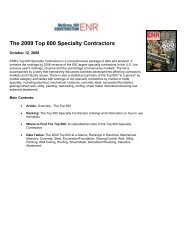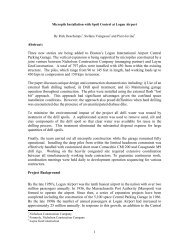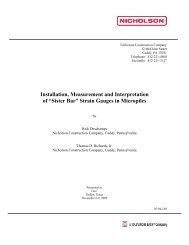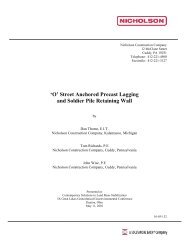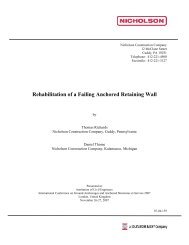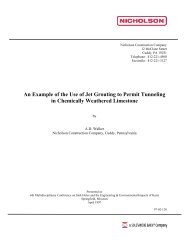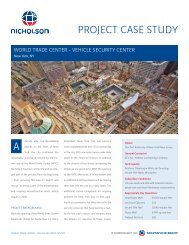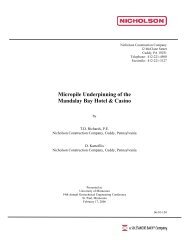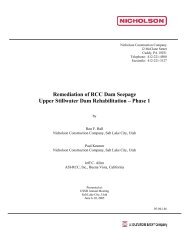Post-Tensioned Stabilization of Roy Inks Dam - Nicholson ...
Post-Tensioned Stabilization of Roy Inks Dam - Nicholson ...
Post-Tensioned Stabilization of Roy Inks Dam - Nicholson ...
You also want an ePaper? Increase the reach of your titles
YUMPU automatically turns print PDFs into web optimized ePapers that Google loves.
overturning stability concerns were identified for the spillway section at floodevents greater than, or equal to, the 500-year flood. Preliminary designalternatives included stabilizing the dam using high capacity, multiple-strand,post-tensioned anchors, large numbers <strong>of</strong> lower capacity post-tensionedanchors, or mass gravity concrete overlays. High capacity, multiple-strand, posttensionanchors were determined to be the most cost-effective solution forstabilization the dam and were selected for final design.DESIGN CHALLENGESThe selected stabilization approach was successfully demonstrated for LCRAduring the stabilization <strong>of</strong> Alvin Wirtz and Buchanan <strong>Dam</strong>s. Lessons learned onthe previous two dams were applied during the design and construction <strong>of</strong> theanchors for <strong>Inks</strong> <strong>Dam</strong>. These lessons learned are discussed later in this paper.However, <strong>Inks</strong> <strong>Dam</strong> presented several design challenges that made this projectunique. The configuration <strong>of</strong> the spillway and rock outcropping at the left bankresulted in a cross section that varies substantially and a discharge that includessignificant three-dimensional hydraulic effects. The challenge <strong>of</strong> making a goodestimate <strong>of</strong> the hydrodynamic forces on the spillway was accomplished throughthe UWRL hydraulic modeling program.Detailed crack mapping revealed the spillway was severely cracked in the upperlifts and the concrete was deteriorating. Visual observations <strong>of</strong> the drilling coresand laboratory test data indicated that the concrete was <strong>of</strong> poor quality with somehoneycombing and little or no bond between many <strong>of</strong> the lift joints. Furthermore,the top ten feet <strong>of</strong> the spillway had lower unit weights and compressive strengthsthan the rest <strong>of</strong> the structure. Finally, significant leakage was observed throughseveral <strong>of</strong> the lift joints across the entire length <strong>of</strong> the spillway, especially at thefirst lift joint below the crest.The design <strong>of</strong> the post-tension system required careful consideration fortransferring post-tension anchoring forces into the structure. The design teamwas faced with a challenging question: How do you take large point loads andtransfer them into a structure comprised <strong>of</strong> irregularly fractured, poor qualityconcrete blocks? The design team developed an innovative approach using apractical solution. The simplest approach to stabilizing the structure would be tojust clamp all the pieces together and hold the structure to the foundation below.Figure 3 shows the design teams simple stabilization concept. We knew whatwe wanted to do, but the challenge was how to do it.



